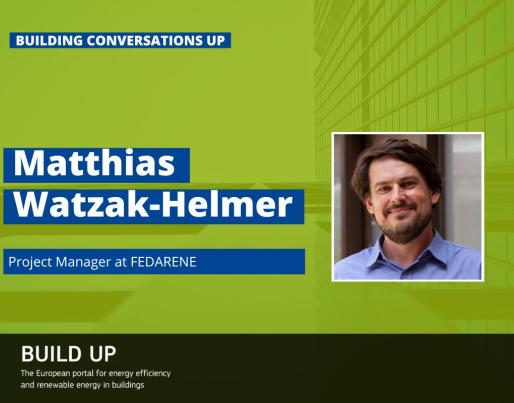
Matthias Watzak-Helmer: “Citizens have a crucial role in implementing the energy transition”

Matthias Watzak-Helmer: “Citizens have a crucial role in implementing the energy transition”
Matthias Watzak-Helmer is a project manager at FEDARENE the European Federation of Agencies and Regions for Energy, Climate and Environment. His activities focus on supporting the implementation of regional solutions with respect to renewable energy communities, energy data management and climate adaptation.
Matthias is an energy engineer with over 10 years’ experience of working with regions to implement sustainable heating and cooling solutions. Within FEDARENE he is coordinating the activities of projects funded by the European Commission, including ConnectHeat, ePLANET, REGILIENCE, and MIP4Adapt.
LinkedIn Instituto Tecnológico de Canarias
BUILD UP (BUP): Could citizens be the means to accelerating the decarbonisation of cooling, for example, through energy communities?
MATTHIAS WATZAK-HELMER (MW-H): I believe that citizens have a crucial role in implementing the energy transition. Citizens will be either key enablers or will hinder the energy transition if they are not included in the developments properly. Citizens are the ones who suffer and benefit from the actions at the same time, and therefore the solutions have to be designed for them, and together with them, to ensure acceptance of the change. Energy communities are a key instrument to ensure broad acceptance.
The technology to decarbonise the cooling sector is available. Sustainable cooling solutions are already implemented. If we can utilise and motivate citizens to participate in community energy initiatives, decarbonisation will be substantially accelerated.
BUP: Why do you think the cooling potential has not been fully exploited in energy communities?
MW-H: From my experience, there are different reasons for not unleashing the full potential of sustainable cooling solutions in energy communities. In fact, a lot of them are like the ones that heating communities are facing. At the moment, the regulation for community solutions in the heating and cooling sector is vague or not existing. This makes it difficult for investors, interested actors, and active citizens to proceed with the implementation of their ideas as they lack planning certainty. Heating and Cooling communities, compared to implementing single solutions for houses or apartments, show great potential as they offer a larger variety of sustainable technologies and sustainable solutions, including peak shifting and demand management.
”At the moment, the regulation for community solutions in the heating and cooling sector is vague or not existing”
BUP: What are the major barriers in the EU to the development of sustainable cooling in energy communities?
MW-H: The transposition of the Renewable Energy Community (REC) and Citizen Energy Community (CEC) definitions to enable sustainable energy communities is progressing. More and more member states are including REC and CEC definitions in their national legislation. Unfortunately, the focus is mainly on the electricity market and the heating and cooling sector does not play a central role in the transposition so far. Regulations with respect to heating and cooling energy communities are crucial for planners and citizens to have planning certainty. I believe that community solutions can speed up the decarbonisation of the heating and cooling sector and unleash the implementation of sustainable cooling solutions. Within the project ConnectHeat, all partners are addressing these issues and working on solutions.
BUP: What is the main goal of the ConnectHeat project and what is the strategy behind the development of the seven pilot areas?
MW-H: The ConnectHeat project is aiming at decarbonising the heating and cooling sector by testing and implementing solutions in seven regions. Our strategy is to enable and support the local community to implement solutions by sharing knowledge and tools and highlighting opportunities to them. The seven pilot regions are spread across Europe (BE, BL, ES, HR, IT, DE, PT) and have different starting points and focus on different solutions and sectors. This shall ensure that we develop a set of recommendations and good practice solutions to show that community energy in the heating and cooling sector can be widely implemented and is sustainable across Europe.
“Community energy in the heating and cooling sector can be widely implemented and is sustainable across Europe”
BUP: Could you explain what type of actions the project is going to undertake in those pilot areas? What are the expected outcomes?
MW-H: The ConnnectHeat team is working in all seven regions on establishing local communities through an orchestrated set of activities. First, an intensive capacity-building programme will enable local stakeholders and communities to take action and speed up the implementation by benefiting and understanding engagement strategies, financial opportunities, legal and organisational conditions, and non-financial benefits. Secondly, an enabling policy framework and a bluebook on how to best take action will be developed. And finally, the already established local advisory groups will ensure and support the quick implementation of local community energy solutions tailored to the different local circumstances.
BUP: Could you go a bit more in detail concerning the technical solutions and systems to be developed taking as an example a specific target area?
MW-H: On the Canary Islands, our local partner ITC – Canary Islands Institute of Technology focuses on establishing a local district heating and cooling network. ITC with its extensive over 25 years of experience in renewable energy generation and storage, energy efficiency and demand management is supporting the local community. Within the municipality of San Bartolomé de Tirajana in Gran Canaria Island the energy consumption is mainly caused by tourist activities which consumes over half the total energy consumption with around 2/3 of this consumption caused by heating (domestic hot water and swimming pool heating) and cooling (space cooling), which both occur all season long. The regional solution aims to best benefit and utilise the waste heat from the cooling demand. The extracted waste heat utilised by the cooling demand will fuel the heating demand from different utilities with the use of a local low-temperature district heating grid.

